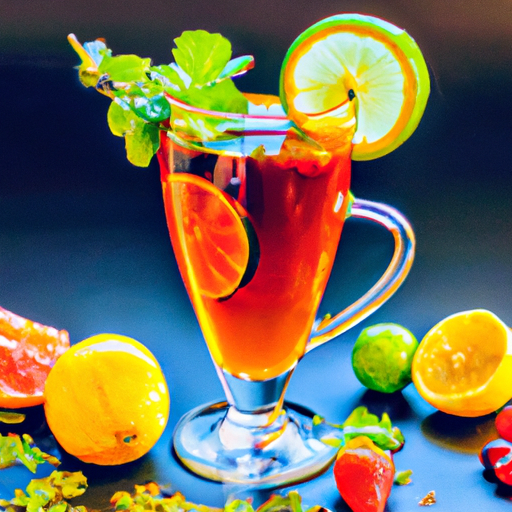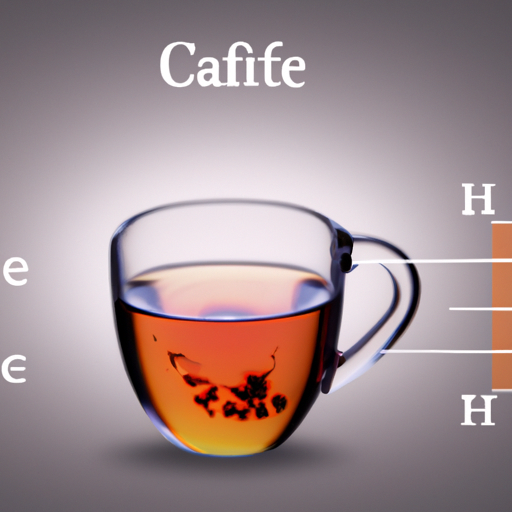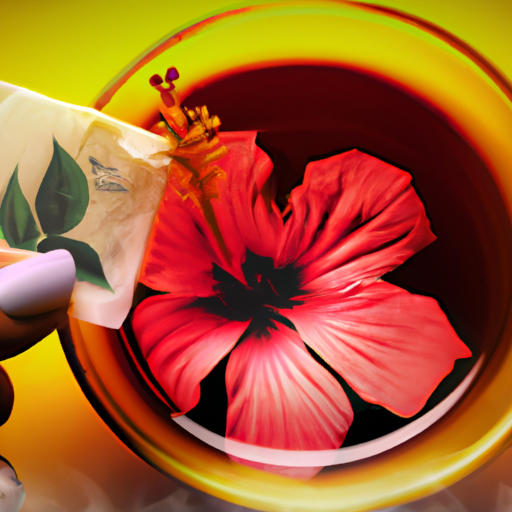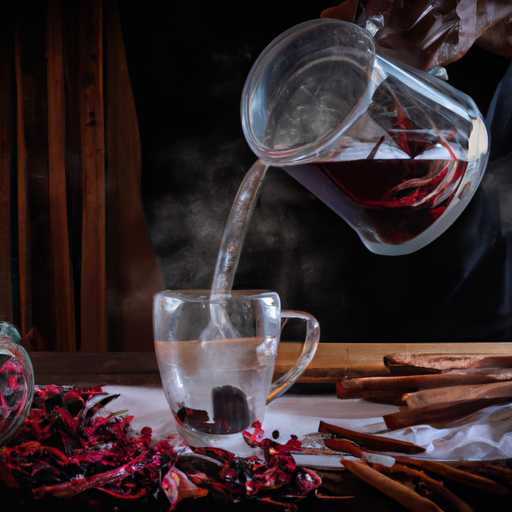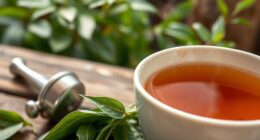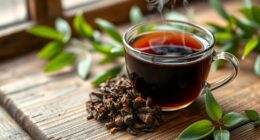As an enthusiast for trying out new taste combinations, I’ve recently developed a strong liking for hibiscus tea. This lively, sour drink is created using the dried outer parts of the hibiscus flower, offering a brilliant red hue and a sharp taste that delivers both refreshment and gratification.
But what should you serve with hibiscus tea to really make it shine? In this article, I’ll be sharing some of my favorite pairings for hibiscus tea, whether you’re looking for something savory or sweet, crunchy or creamy.
From classic tea accompaniments to international cuisine pairings that might surprise you, there are plenty of delicious ways to enjoy this unique beverage. So if you’re a fellow foodie looking to take your hibiscus tea game up a notch, keep reading!
Key Takeaways
- Hibiscus tea pairs well with both sweet and savory foods, such as potato chips, meat dishes, cheese, cakes, and salad dressings.
- It complements spicy Indian and flavorful Thai dishes, as well as Mediterranean and Mexican cuisine.
- Non-alcoholic options include iced hibiscus tea, hibiscus lemonade, and hibiscus mint tea, while cocktails like the Hibiscus Margarita can also be made with it.
- Experimenting with flavors like lemon, ginger, mint, and lavender can lead to endless options for unique beverages, and creative garnishes can enhance the aesthetics and flavors of drinks.
The Flavor Profile of Hibiscus Tea
If you’re into tangy and fruity flavors, hibiscus tea might just be your new favorite drink! Hibiscus tea is a refreshing and delicious beverage that’s made from the dried calyces of the hibiscus flower. The flavor profile of hibiscus tea is both tart and sweet, making it perfect for those who love bold tastes.
When exploring hibiscus tea flavors, there are two main options: herbal blends or fruit infusions. Herbal blends often incorporate other flowers or herbs to create a unique taste experience. On the other hand, fruit infusions use actual pieces of fruit to add sweetness and depth to the brew.
Regardless of which type you choose, hibiscus tea has a distinct flavor that pairs well with a variety of foods. From sweet treats like pastries and cakes to savory dishes like roasted meats and vegetables, this versatile drink can complement any meal.
So let’s move on to discussing some savory pairings that will elevate your next cup of hibiscus tea!
Savory Pairings
Satisfy your cravings for something salty by enjoying hibiscus tea with a plate of crispy potato chips. The tartness of the tea complements the saltiness of the chips perfectly, creating an addictive flavor combination that is hard to resist.
If you’re in the mood for something more substantial, try pairing hibiscus tea with meat dishes like grilled chicken or beef kebabs. The floral notes in the tea balance out the richness of these dishes and add a unique twist to your meal.
Another great savory pairing for hibiscus tea is cheese. Whether it’s a creamy brie or a sharp cheddar, cheese pairs well with this floral beverage. The acidity in the tea cuts through the richness of cheese and enhances its flavors, making each bite all the more satisfying. For a sophisticated snack, create a cheese board with different types of cheeses and enjoy it alongside a cup of hot hibiscus tea.
As much as I love savory pairings with hibiscus tea, I can’t deny that sweet pairings are just as delicious. But before we delve into those options, let’s explore another savory option: salads! Hibiscus tea adds an unexpected depth to any salad dressing and brightens up leafy greens beautifully.
Now that we’ve covered some savory options, let’s talk about how to satisfy your sweet tooth when sipping on this delightful brew!
Sweet Pairings
When it comes to indulging in something sweet, you might be surprised to learn that hibiscus tea is a popular ingredient in desserts, with over 1,000 recipes featuring it on a well-known recipe website. This floral and tangy tea adds an interesting twist to classic dessert options and can be paired with unique combinations of ingredients for a delightful treat.
One popular way to incorporate hibiscus tea into desserts is by infusing it into cakes or cupcakes. The vibrant pink color of the tea makes for a beautiful presentation and the tart flavor pairs well with creamy frosting or fruit toppings.
Another option is to use hibiscus tea as a glaze for baked goods like donuts or scones, adding a subtle sweetness and tartness that elevates the flavors. If you’re feeling more adventurous, try pairing hibiscus tea with unexpected ingredients like dark chocolate or gingerbread. The combination of these flavors may seem unusual at first, but they complement each other surprisingly well and create a unique and memorable dessert experience.
Don’t be afraid to experiment and have fun with incorporating hibiscus tea into your sweet treats.
Moving onto snack pairings, there are plenty of savory options that go great with hibiscus tea as well!
Snack Pairings
For a satisfying midday snack, picture yourself indulging in a crispy baguette with tangy goat cheese, balanced by the fruity and floral notes of a refreshing hibiscus-infused iced tea. This snack pairing is not only delicious but also offers healthy options that won’t leave you feeling guilty.
Goat cheese is lower in fat and calories than other cheeses, and hibiscus tea has antioxidants that may aid in reducing inflammation. If you’re looking for more indulgent treats to pair with your hibiscus tea, consider trying some chocolate-covered strawberries or dark chocolate bark with nuts and dried fruit.
The tartness of the hibiscus will complement the sweetness of the chocolate and enhance its rich flavor profile. These treats offer a perfect balance between health benefits and indulgence.
Whether you’re aiming for healthier options or treating yourself to something sweeter, there are plenty of snack pairings that go well with hibiscus tea. Next up, let’s explore some exciting tea pairings that will take your taste buds on an adventure without ever leaving your home.
Tea Pairings
If you’re a fan of spicy foods, you might enjoy pairing a bold chai tea with a plate of samosas. Imagine biting into the crispy pastry filled with savory spiced potatoes and peas, followed by sipping on the warm and invigorating blend of black tea, ginger, cinnamon, cardamom, and cloves. The combination of the rich flavors in both the tea and food creates an explosion of taste in your mouth that is sure to satisfy any craving.
Tea and food pairings are not only delicious but can also have health benefits. For example, green tea has been shown to boost metabolism and aid in weight loss when paired with healthy meals. Additionally, herbal teas like chamomile or peppermint can help soothe digestion after a heavy meal. By choosing the right tea to complement your food choices, you can enhance both the flavor and nutritional value of your meal.
When it comes to cocktail pairings with hibiscus tea, there are endless possibilities. From fruity sangrias to spicy margaritas, hibiscus adds a unique twist to classic cocktails. But before we dive into those options, let’s explore some non-alcoholic beverage pairings for hibiscus tea that will leave you feeling refreshed and satisfied.
| Beverage | Description | Emotion |
|---|---|---|
| Iced Hibiscus Tea | A refreshing drink perfect for hot summer days | Refreshing |
| Hibiscus Lemonade | A tangy twist on classic lemonade | Zesty |
| Hibiscus Mint Tea | A soothing blend that calms the senses | Relaxing |
Now that we’ve explored some non-alcoholic options for pairing with hibiscus tea let’s move onto cocktail pairings without missing a beat!
Cocktail Pairings
Let’s shake things up and add a touch of tropical flair to our cocktail game with some creative hibiscus tea concoctions. As a mixologist, I’ve experimented with various ingredients and found that hibiscus tea pairs well with both light and dark spirits.
For example, adding tequila or rum to hibiscus tea creates a refreshing summer drink that’s perfect for sipping on the beach. One popular recipe that many people enjoy is the Hibiscus Margarita. To make this delicious cocktail, simply combine 2 oz of silver tequila, 1 oz of fresh lime juice, 1 oz of hibiscus tea syrup, and ice in a shaker. Shake it well until chilled and strain into a glass filled with ice. Garnish with lime wedges or hibiscus flowers for an extra touch of elegance.
Mixology tips are essential when creating cocktails using hibiscus tea. One tip to keep in mind is to balance out the sweetness by adding tart flavors like citrus fruits or bitters. Another tip is to experiment with different types of alcohol, such as gin or vodka, for unique flavor profiles.
Now let’s move on to mocktail pairings, where we can explore non-alcoholic options for those who prefer to skip the booze but still want to indulge in the taste of hibiscus tea-based drinks.
Mocktail Pairings
Now, it’s time to explore some non-alcoholic options for those who want to enjoy the taste of hibiscus tea without the buzz. Did you know that according to a recent survey, 30% of Americans are choosing to drink less alcohol? Luckily, there are plenty of alcohol-free alternatives that pair perfectly with hibiscus tea.
One option is to mix hibiscus tea with lemonade and top it off with fresh berries and mint leaves. This refreshing mocktail not only complements the tartness of the hibiscus tea but also adds a sweet and fruity flavor. Another idea is to combine hibiscus tea with ginger ale and garnish it with a slice of orange or lime for an extra citrusy kick. The spiciness of ginger ale pairs well with the floral notes in hibiscus tea, making this mocktail a perfect choice for any occasion.
When serving these mocktails, don’t forget about creative garnishes! Adding colorful fruits or herbs can enhance the aesthetics and flavors of your drinks. Try using edible flowers like rose petals or lavender buds as a beautiful finishing touch. With these alcohol-free alternatives and creative garnishes, you can still indulge in the delicious taste of hibiscus tea while staying sober.
Looking for more ways to enjoy hibiscus tea? Let’s move on to our next section about brunch pairings where we will explore some food options that complement this flavorful beverage.
Brunch Pairings
When it comes to brunch, I’ve got a few go-to dishes that never disappoint.
Avocado toast is always a must-have for me. The creamy texture of the avocado pairs perfectly with the crunchiness of the toast.
And who can resist a stack of fluffy pancakes drizzled with syrup?
Another classic brunch dish that I love is Eggs Benedict. The combination of poached eggs, crispy bacon, and rich hollandaise sauce is simply irresistible.
Avocado Toast
To elevate your avocado toast game, you could pair it with a refreshing and floral hibiscus tea. Avocado toast is already a popular brunch item due to its healthy fats and endless garnish options.
But adding a cup of hibiscus tea can take this dish to the next level.
Hibiscus tea’s tartness complements the creaminess of the avocado, while its floral notes add an extra layer of complexity to the dish.
Plus, hibiscus tea is known for its health benefits such as reducing blood pressure and aiding in digestion, making it a perfect addition to any meal.
So next time you’re enjoying some avocado toast, don’t forget to pair it with a delicious cup of hibiscus tea.
As we move on from avocado toast, let’s talk about another brunch staple: pancakes.
Pancakes
You can’t resist the fluffy goodness of pancakes, especially when they’re made just right. The key to achieving that perfect texture is using a batter that’s not too thick or too thin, and cooking them on a hot griddle until they’re golden brown on both sides.
Once your pancakes are ready, it’s time to add some flavorful toppings. For a hibiscus tea pairing, I recommend using fruity syrup like raspberry or blueberry to complement the floral notes in the tea. The combination of fluffy texture and sweet fruit makes for an indulgent breakfast treat that’s sure to satisfy your cravings.
And if you want to take it up a notch, try adding some fresh berries or sliced bananas on top for an extra burst of flavor.
Now let’s move onto another classic brunch dish: eggs benedict!
Eggs Benedict
Wow, nothing compares to sinking your teeth into a perfectly poached egg smothered in rich hollandaise sauce atop a toasted English muffin for the ultimate brunch experience.
The silky texture of the eggs and the tangy flavor of the hollandaise sauce create a perfect harmony that leaves you craving for more.
As someone who loves experimenting with different flavors and food combinations, I’ve found that hibiscus tea pairs exceptionally well with this classic dish.
The floral notes of hibiscus tea complement the richness of eggs Benedict beautifully.
Sipping on a hot cup of hibiscus tea while indulging in this savory dish helps cleanse your palate after each bite, leaving you feeling refreshed and energized.
It’s no wonder why eggs Benedict with hibiscus tea has become one of my go-to brunch combinations! But, international cuisine pairings take this pairing game to another level.
International Cuisine Pairings
If you’re in the mood for something exotic, try pairing hibiscus tea with spicy Indian curry or flavorful Thai dishes. The floral and tangy notes of hibiscus tea complement the bold spices and flavors of these international cuisines.
In India, food culture is a significant part of daily life, and their cuisine reflects that with its diverse range of spices and herbs. Hibiscus tea’s natural sweetness can help balance out the heat from spicy curries like vindaloo or chana masala.
Fusion cuisine has been gaining popularity worldwide, blending traditional recipes with modern twists. Experimenting with fusion-style dishes can be exciting when paired with hibiscus tea. For example, Korean BBQ tacos or Japanese sushi rolls infused with tropical flavors like mango or pineapple can create an unexpected yet delicious combination when enjoyed alongside a cup of iced hibiscus tea.
In addition to Indian and Thai foods, other international cuisines pair well with hibiscus tea too! Mediterranean dishes like falafel wraps or Greek salads offer fresh ingredients mixed together harmoniously on one plate. Or take a trip south to Mexico for some authentic tacos al pastor topped off with a refreshing glass of iced hibiscus tea.
The possibilities are endless! Don’t be afraid to experiment with your own pairings; who knows what unique combination you may discover?
Experimenting with Your Own Pairings
I love experimenting with different flavors and discovering new pairings.
One thing that’s helped me keep track of my favorite combinations is keeping a journal where I can jot down notes about the flavors, textures, and overall experience.
I also enjoy sharing my discoveries with friends and getting their feedback on what works well together.
Trying New Flavors
Pairing hibiscus tea with new and unique flavors can be an exciting adventure in exploring combinations. It’s one of my favorite things to do when I want unexpected delights in my cup.
Some of the flavors that I’ve tried so far include lemon, ginger, mint, and lavender. These additions bring out different notes in the hibiscus tea, giving it a complex flavor profile.
When trying new flavors with hibiscus tea, it’s essential to experiment with small amounts first to find the right balance before committing to a full cup. Adding too much of any ingredient can overpower the delicate taste of hibiscus. But once you find the right combination, it can be a game-changer!
Keeping a journal of your experiments is also helpful as it allows you to look back on what worked well for future reference.
Keeping a Journal
To really spice up your hibiscus tea game, why not try keeping a journal of all the unique flavor combinations you experiment with? Bullet journaling is an excellent way to keep track of all your favorite recipes. Not only does it provide a space for reflection prompts that help you remember what worked and what didn’t, but it also allows you to jot down any new ideas that pop into your head.
Creating a table in your journal can be especially helpful when experimenting with different flavors. Here’s an example:
| Base Tea | Fruits | Herbs/Spices |
|---|---|---|
| Hibiscus | Mango | Ginger |
| Green | Pineapple | Lemongrass |
By keeping track of what works well together, you’ll have endless options for creating delicious and unique beverages. Plus, once you’ve perfected your recipe, sharing with friends can be a great way to show off your skills without having to say a word!
Sharing with Friends
Sharing your unique tea creations with friends can be a fun and exciting way to introduce them to new flavor combinations they may have never tried before.
When it comes to hibiscus tea, there are plenty of options for pairings that will impress your guests at your next gathering or get-together. Some popular choices include pairing hibiscus tea with lemon or lime for a refreshing citrus twist, while others recommend adding ginger or mint for an extra kick of flavor.
If you really want to impress your friends, consider hosting a tea party where you can showcase your knowledge of different teas and flavor combinations. This is a great opportunity to share experiences and learn from each other about what pairs well together.
Whether you choose to serve hibiscus tea on its own or experiment with different pairings, hosting a gathering centered around this delicious beverage is sure to leave everyone feeling satisfied and enlightened about the wonderful world of tea.
Frequently Asked Questions
What are the health benefits of hibiscus tea?
As someone who loves to drink hibiscus tea regularly, I’ve researched the health benefits of this delicious beverage.
One of the most notable benefits is its ability to lower blood pressure. Drinking hibiscus tea can help reduce both systolic and diastolic blood pressure levels in individuals with hypertension.
In addition, hibiscus has properties that can boost the immune system and protect against oxidative stress. These effects are attributed to the presence of antioxidants like flavonoids and anthocyanins in hibiscus tea.
Overall, incorporating hibiscus tea into your diet may provide numerous health benefits related to cardiovascular health and immune function.
How is hibiscus tea typically prepared?
When I prepare hibiscus tea, I typically use loose dried hibiscus flowers and steep them in boiling water for 5-10 minutes. The longer the steeping time, the stronger and more tart the flavor will be. Some people prefer to add sweeteners like honey or sugar to balance out the tartness.
Other brewing methods include using teabags or cold brewing overnight in the fridge. It’s important to note that hibiscus tea can easily become bitter if oversteeped, so it’s best to start with a shorter steeping time and adjust according to personal taste preferences.
Overall, there are various ways to prepare hibiscus tea depending on individual preference and desired flavor profile.
Can hibiscus tea be enjoyed hot or cold?
Hibiscus tea can definitely be enjoyed both hot and cold, depending on your preference. When brewing the tea, it’s important to note that the brewing technique will differ slightly depending on whether you want a hot or cold beverage.
For hot hibiscus tea, I typically boil water and steep the hibiscus flowers for around 5-7 minutes before straining out the flowers and enjoying my cup of tea.
For a refreshing glass of cold hibiscus tea, I like to brew a stronger concentration of the tea by using more flowers and letting them steep in room temperature water for several hours before adding ice and serving chilled.
Overall, whether you prefer your hibiscus tea hot or cold, there are many different ways to prepare this delicious beverage!
Where can I purchase hibiscus tea?
I’m a huge fan of hibiscus tea and I always make sure to have some on hand. When it comes to availability, you can find hibiscus tea at most health food stores or online retailers. Some of the best brands include Traditional Medicinals, Harney & Sons, and The Tao of Tea.
These brands use high-quality ingredients and offer a variety of flavors to choose from. As for what pairs well with hibiscus tea, there are plenty of options! Personally, I love pairing it with fresh fruit or a light salad for a refreshing snack. It also goes great with spicy foods as it helps to cool down your palate.
Overall, hibiscus tea is a versatile beverage that can be enjoyed in many different ways!
What are some common flavor profiles found in hibiscus tea blends?
When it comes to hibiscus tea blends, there are several common flavor profiles that you can expect. These blends often have a tart and tangy taste, with a slightly sweet finish.
Some of the fruit pairings that work well with hibiscus tea include lemon, lime, orange, and raspberry. If you’re looking for cocktail recipes using this flavorful tea, try mixing it with vodka or gin and adding a splash of citrus juice.
Another option is to blend hibiscus tea with fresh fruit purees or syrups for a refreshing summer drink. Overall, hibiscus tea is a versatile ingredient that pairs well with many different flavors and can be used in a variety of creative ways in your culinary endeavors.
Conclusion
So there you have it – a comprehensive guide on what pairs well with hibiscus tea. From savory dishes to sweet treats, snack pairings to international cuisine, and even mocktails and brunch plates, the possibilities are endless.
But did you know that hibiscus tea is not only delicious but also has some incredible health benefits? According to a study published in the Journal of Nutrition, consuming hibiscus tea can significantly reduce blood pressure levels in individuals with hypertension.
In fact, after just six weeks of drinking three cups of hibiscus tea per day, participants experienced a reduction in systolic blood pressure by an average of 7.2 mmHg! So not only can you enjoy the delicious taste of hibiscus tea paired with your favorite foods, but you can also feel good knowing that it’s doing wonders for your health.

